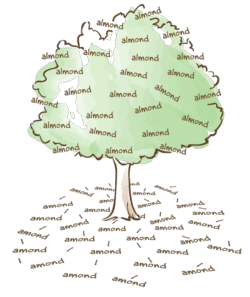About the Project
Amond vs Almond: a California Colloquialism in a Nutshell
If you've ever seen or been a part of an almond harvest, there is a lot of shaking involved. The fastest way to get the majority of the almonds out of the tree is by shaking it with a mechanical tree shaker, or by pounding the tree trunk with a large rubber mallet. Either way, around 2 billion pounds of almonds get shaken off of their trees each year in California.
You may or may not have already heard the saying:
"When it's in the tree, it's an almond. When it's on the ground, it's an amond... because the "L" got shaken out of it!"
This has become the standard saying for those who use the "amond" pronunciation, but it still doesn't offer any historical records or evidence for the true reason why people say "amond" rather than "almond."
Another defense is usually a comparison to other similar words in the English language, like the word salmon:
"You don't say 'SALLmon,' you say 'sah-mon.'"
But the word salmon can be pronounced both ways according to the Merriam-Webster Dictionary, just like the word almond.
David Doll, UC ANR's former pomology farm advisor for Merced county and a major contributor to The Almond Doctor, worked with almond growers throughout California for the UC Cooperative Extension for 10 years. He’s met many almond growers and says that about 30% of the ones he sees are third-generation almond growers and the majority of them say “amond.”
“It’s usually the ones who have been farming almonds a lot longer than the recent influx of growers in the industry,” he said. “The farmers whose families have been around for at least 30 to 40 years usually say ‘amond.’”
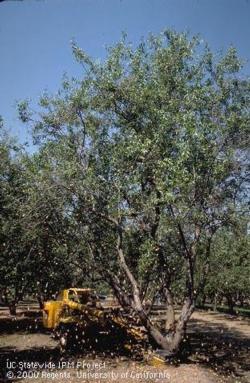
When asked about the geographic boundaries of farmers who say “amond” as opposed to “almond,” he said that it was harder to pinpoint than you might think. He started with some of the counties that have been producing almonds the earliest, like Butte, Merced, Stanislaus, San Joaquin, etc. and compared them to some of the newer almond-producing counties, saying that the newer almond-growing families usually keep the “L” in “almond.”
“Everybody thinks that it’s just up North, but it’s not,” he said. “I hear it throughout the San Joaquin Valley as well.”
However, Doll said that the one exception was Kern County.
“If you go down to Kern County, you don’t hear it as much, but they’ve been farming almonds for about 50 years, so I think it has something to do with the regional ties.”
David was a California transplant, so had never heard “amond” until coming to work for UC ANR. One of the first times he had heard that pronunciation was in Modesto. In fact, originally he thought “amond” was just something people said in Modesto.
“I went to a meeting once and someone was calling them ‘amonds,’ so I said, ‘In that case they must be called ‘wanuts,’” David reminisced.
“And the guy said, ‘What do you mean, wanuts?’”
“So I said, well if you shake the ‘L’ out of almonds then you should shake the ‘L’ out of walnuts too, so they’d be ‘wanuts.’”
“He said, ‘No that’s just not right, what’s wrong with you?’” he laughed.
UC ANR’s Joe Connell, UC Cooperative Extension farm advisor emeritus in Butte county, is a California native but wasn’t raised on “amonds.” The first time he heard that pronunciation was when he became an intern with UC Cooperative Extension in Butte county in the Spring of 1978 when he was placed with an almond farm advisor.
“Upon arrival, I almost immediately heard discussions about ‘amonds,’” he said.
He was raised in the Bay Area and was definitely an “almond” person, he said. Then when he arrived in Butte County he was converted to saying 'amond.’
“I’m still torn between my upbringing and my professional activities,” he said. “I go back and forth. When I’m talking to the growers in my area, I talk about ‘amonds,’ but I also slip up and I talk about ‘almonds.’”
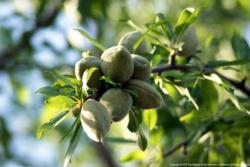
He says that from his experience, either pronunciation is perfectly acceptable within the almond growing community. It’s when you start saying “amond” to people outside of the industry that you start getting funny looks.
Joe confirmed David’s notion that the long-time growers in the traditional almond growing areas of California are most likely to say “amond” rather than “almond.”
“My impression is that it’s more of a tradition in the older almond-producing districts and not so much in the new almond-producing areas, where the growers converted their land into almonds from some other crop. Since there hadn’t been a traditional almond district in those parts of the state, they didn’t get the habit of saying ‘amond,’” he said. “Folks in the Butte county area mostly talk about ‘amonds’ if they’re long-time almond-farmers or are a part of the industry, and I think that’s the same in other parts of the state, in Ripon and Modesto certainly, and all the way down to Merced,” he said.
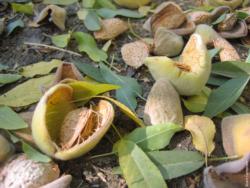
But as you get further South, where the almond production is newer they say “almonds” rather than “amonds,” Joe said.
“The [almond] acreage really started taking off in the 1970s and a lot of new areas began developing in the San Joaquin Valley when the California Water Project came down there,” he said. “Then some of the traditional areas that were growing grapes and stone fruits started planting almonds in Fresno and Tulare counties.”
We think the root of this saying lies deeper than just a quirky joke related to shaking the hell out of almond trees during harvest, but because tracking the etymology of a word that is spelled the same but pronounced differently is very difficult, we turned to history instead.
What the L?
OUR THEORY: Early California immigrant almond farmers, who were predominantly European, settled in pockets according to their ethnicity/family/friends. They used their native word for almond until they began speaking more English. Some of the farmers may have kept their native word, or combined it with the English "almond" to create a slang word for it.
Take a look at some of the various translations of "almond." You can see more here.
|
One only needs to look at the large ethnic diversity that calls California home to wonder why there were only two pronunciations of "almond" that rose to mainstream usage in state-wide affairs. People from all over the world have been coming to California since 1849, bringing with them a large variety of everything, including cultures and languages. One portion of an article published in 1986 in the American Geographical Society's journal, Geographical Review, titled "A Geographer Looks at the San Joaquin Valley," sums up California's early agricultural ethnic diversity and history quite nicely:
The succession of ethnic groups that have supplied the laborers began with the Chinese . . . The Japanese came next but in the end had the same fate, although they were the largest factor in the valley labor market as late as 1909. Today Nisei repatriates from World War II internment camps are among the most successful growers in the valley. So too are descendants of the wave of Armenian immigrants who began arriving in the Fresno area in the 1890s and took early control of the dried-fruit industry. No ethnic group is more closely tied to one industry than the Portuguese. Dairying . . . is largely in the hands of Portuguese from the Azores or their descendants. Communities like Hanford, Newman, and Gustine have large Azorean minorities whose presence is identifiable by the IDES social hall. There are now more Azoreans in California than in the Azores.
Other European ethnic groups who are closely identified with certain places include Swedes at Turlock and Kingsburg, Yugoslavs at Delano, Dutch at Ripon, Germans at Reedley and Lodi, and Basques at Bakersfield. Italians and Italian-Swiss are concentrated in the wine industry and in dairying. Only a few years ago Filipinos were still the most numerous group of field-workers in the asparagus fields of the delta. Like the Sikhs from the Punjab, their valley base is Stockton. There are Russians in Kerman, Assyrians in Modesto and Turlock, and Japanese around Livingston. For most of these ethnic groups a church or religion provides the cultural glue-Dutch Re-formed, Mennonite, Old German Dunkard, Armenian Christian, Buddhist, Hindu, or Sikh.
The immigration from the Dust Bowl during the great depression was another sort-white Protestant Anglo-Saxons from Texas and Oklahoma who were refugees from drought and poverty . . . In those days cotton was still harvested by hand, and seasonal demands for labor were large, with migrant pickers at the very bottom of the economic ladder. But mechanization and new irrigation techniques like overhead sprinklers and drip irrigation changed job patterns and brought increased demands for skills and higher wages. Today first- and second-generation Okies occupy dominant positions throughout the valley.
The black component of the Dust Bowlers-and they continued coming during World War II-is confined to the large valley cities . . . A small black colonization project in Kings County was organized in 1910, but it fell victim to bad water and alkali. The area is now a state park. It is different with the Mexican-Americans or Chicanos. Since World War II a distinctive Mexican subculture has emerged in the valley. The old-stock Hispanics, some dating back more than a century, are rarely found in the fields. The new arrivals, whether legal or undocumented, do the pruning, the planting, and the harvesting. In each valley county between 20 and 30 percent of the population is Hispanic,-with Fresno at the high end of the range . . . (Parsons 378-379).
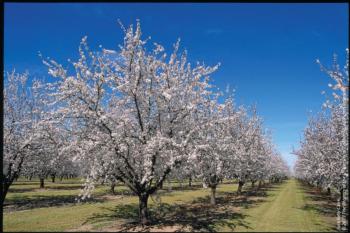
When it comes to almonds, though, the early Dutch immigrants are one of the few who have tended to stand out in the "amond" pronunciation. According to Sally M. Miller in "Changing Faces of the Central Valley: The Ethnic Presence," a mission from the Dutch Reformed Church was established in Modesto in 1904, and by 1920 there were nearly 4,600 Dutch-born people living in California with around 1,000 of them in the Central Valley.
At the town of Ripon, located between Modesto and Stockton, the first Dutch residents arrived by train from North Dakota in 1916, and it soon became the most famous Dutch town in California. A Dutch Reformed Church was established at once, and later a Dutch-language school, a convalescent home and other ethnic facilities. The principal occupations that the Dutch of Ripon followed were dairying, including creameries, and the operation of almond orchards (Miller 185-186).
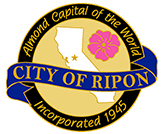
Even to this day there is a strong, almond-centered culture in Ripon, which prides itself as "The Almond Capitol of the World," and even holds an Almond Blossom Parade every year in February. Ripon is also one of many Central Valley towns that predominantly uses the "amond" pronunciation. The Dutch word for "almond" is "amandel."
However, the translation that is closest-sounding to "amond" is the French "amande," which Valley Public Radio's Ezra David Romero goes into in his article, "I Say Almond, You Say Am-end. But Who's Right?"
The entire purpose of this project is to find out, once and for all (if at all possible) who, where, when and/or why the L-less pronunciation of the word "almond" stemmed from in California. We need your help so please take the survey!

